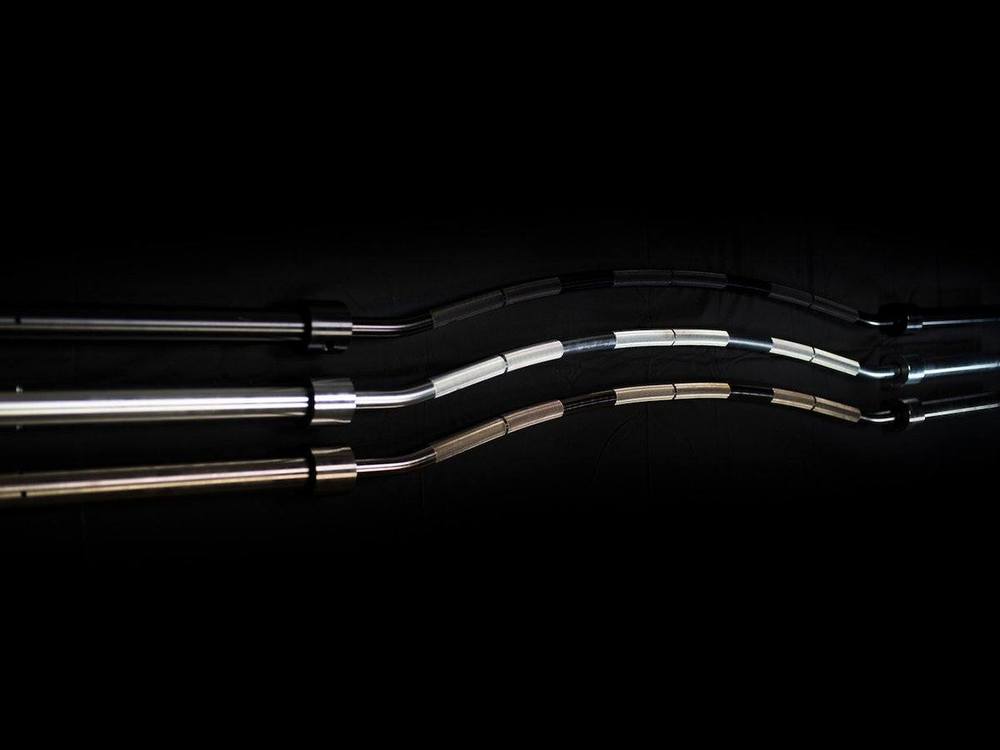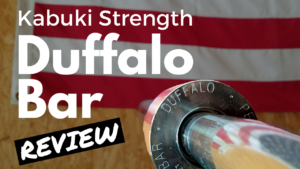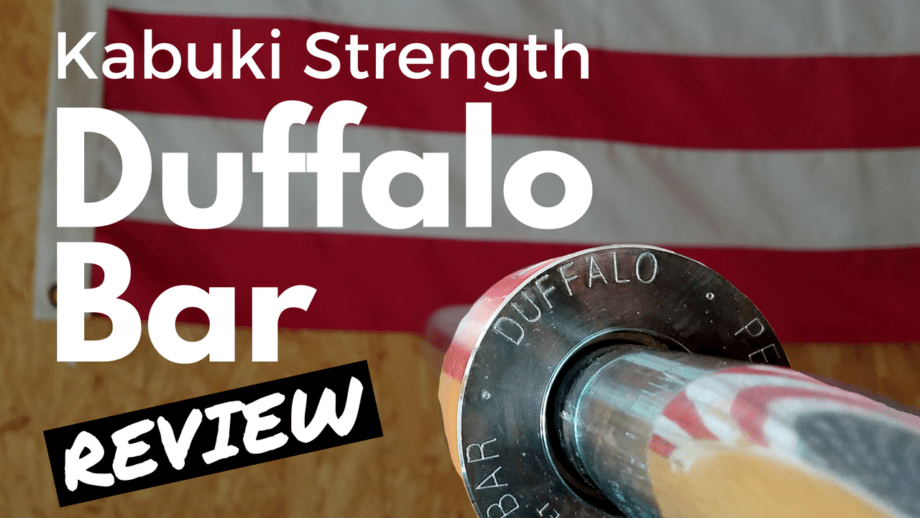We test and review fitness products based on an independent, multi-point methodology. If you use our links to purchase something, we may earn a commission. Read our disclosures.
The Kabuki Strength Duffalo Bar is a new take on an old specialty bar, the Buffalo Bar. After using the Duffalo Bar over two years and hundreds of workouts, we believe the Duffalo Bar is one of the best specialty bars currently available.
Kabuki Strength
Kabuki Strength Duffalo Bar

Product Highlights
- 55-lb cambered barbell
- Designed for squat and bench
- Engineered by Chris Duffin
- Bronze bushing system
- 3 metal finish options
Pros & Cons
Pros
- Made in the USA
- 3 knurl markings
- 195,000 PSI tensile strength
- Good for anyone lacking shoulder mobility
- Aggressive knurling
- 17.25” loadable sleeve
Cons
- Expensive price tag
- No warranty offered with the bar
- Curved design does not sit well in many J-cups
Bottom Line
The Kabuki Strength Duffalo Bar is one of the best specialty bars on the market, however, it comes at a high price. We've tested and reviewed it for nearly two years and find ourselves using the bar for squats more than just about any other. The knurling and bend are vastly superior to cheaper buffalo bars and, as usual, the attention to detail is high. If you're in the market for a new specialty bar and have the cash, this is a great option (but we'd suggest a safety squat bar first.)
The Kabuki Strength Duffalo Bar was released by Chris Duffin out of nowhere.
I was thankful to have the opportunity to review his first invention that was brought to market, the ever-popular ShouldeRok and was looking forward to putting his latest creation, the Duffalo Bar to the test.
The Duffalo Bar packs in all of the features you’d want in a barbell, plus ones you would never have even thought of (more on that later.) Not only does Chris and his team at Kabuki Strength create unique products, but they’re creating the best possible version of products.
I don’t mean it lightly when I state that the last time I was as impressed with a piece of equipment was when I reviewed the Eleiko Training Bar (my very first review.) The Duffalo Bar vastly exceeded my expectations; and to think it’s made right here in the United States by a small company, headed by a 1,000 lb. deadlifter makes it that much sweeter.
With that – let’s get started.
Unboxing

I receive quite a few barbells throughout the year, but I’ve never received one in a box like this.A majority of barbells come in the standard cardboard tube that is not only difficult to open, but getting the barbell out of the tube is material fitting for an episode of the Three Stooges.Seeing as the Duffalo Bar, with its exaggerated arc would most certainly not fit in a straight tube, Kabuki Strength got creative.
Related: Check out the Kabuki Kratos Flywheel Review.

I don’t know whether this is a type of box that can be ordered or if it’s custom-made, but it does an excellent job of keeping the bar from sliding around and protected. If it’s not obvious from the pictures, the cardboard is wrapped around the bar three times. This is important when purchasing any product, but especially when it’s as costly as the Duffalo Bar.
Video Review

Kabuki Strength Duffalo Bar Review
- 210,000 PSI Tensile Strength Heat-Treated Steel
- 55 Pounds
- 30 MM Shaft Diameter
- 19.5″ Sleeves (traditional barbell sleeves are ~ 16″)
- 96″ Total Length
- 2,000 LB Load Capacity (I’m quite certain this is an understatement)
- Bronze Bushing Sleeve Assembly
- Band & Chain Attachment Point
- Bare Steel, Clear Zinc, Electrolysis Zinc, and Black Oxide Plating Available
- Made in USA (Portland, Oregon)

Where do you start with such a unique bar like the Duffalo Bar? I have a typical flow for most barbell reviews, but the uniqueness of this bar doesn’t fit in my usual categorical holes.
With that said, let’s just start with the camber and go from there.
The camber on most Buffalo Bar’s is a slight arc. I wanted to find measurements on exactly what angle the arc of most buffalo bar’s is, but all I can say is it’s pretty minimal. Granted, any bend in the bar will feel much different from the traditionally straight barbell, butit won’t feel a whole lot different.
The advantage of a curved bar is that for squats, it hugs your back. For bench, it changes your wrist angle and allows you to get a deeper range of motion.

The camber on the Duffalo Bar is much more exaggerated than other Buffalo Bars out there; something Kabuki Strength claims took over a year to perfect.
The idea that a curved bar is better for squatting makes a lot of sense. Looking at the anatomy of the back, the multi-radial properties of the bar allow it to sit along the contours of the back. In initially reading Chris Duffin’s writings on the bar, I thought he was trying to sell a product. After using it, I’m a believer.
The Duffalo Bar does seem to wrap around the back better, but also, due to its positioning, my ability to retract my scapulae causes increases in my bracing. Anyone who’s trained for very long recognizes the importance of bracing in heavy movements which, to me, makes this bar that much better for the squat.
Although the squat is where the Duffalo Bar truly shines, it also works surprisingly well for bench and overhead pressing.
The bend of the bar allows the wrist to maintain a healthy angle and I noticed an increase in lat engagement. Whether this was due to the actual curve of the bar, or me being more conscious of using my back during the press is anecdotal. Either way, my press felt natural.
One feature of the Duffalo Bar that is quite unique are the sleeves. They are longer than IWF Approved Barbells (more on that later), but the sleeves are actually angled upwards.

It’s a bit difficult to tell from pictures, but it’s pretty noticeable in person. One other thing you can notice is how long the sleeves are. The above picture is in comparison to a deadlift bar. You should never have a problem loading weight on this bar.
The idea behind the upward angled sleeves is two-fold. For one, it keeps the weight from sliding off. In fact, it does such a good job at that I don’t feel like clips are necessary from keeping the weight sliding around when getting into position (this does not mean they will maintain the weight on the bar during a failed lift, so continue to use collars.)
The second reason is the upward angled sleeve is claimed to produce a similar center of gravity to that of a regular barbell. Is this true? I have no way of judging this other than by feel, and as far as stability goes, the Duffalo Bar does not feel any less stable than my Olympic bars.

Finally, as you would imagine, due to the bar being angled, the range of motion during pressing movements is increased. Although you’re not going to get the ROM of something like a cambered bench bar, you’ll get more than enough to vary your training stimulus.
This idea of varied training stimulus transitions perfectly into the idea of what makes specialty bars such a “special” part of training. Louie Simmons, the architect behind Westside Barbell, is always harping on the idea of changing up equipment to keep improving performance. This notion extends not only to Powerlifting, but also Olympic Lifting, CrossFit, and any other barbell sport. If you want to be the best version of yourself, use every tool available to you.

The attention to detail on the Duffalo Bar is off the charts. There was literally no stone unturned in the formulation and creation of the bar Chris Duffin consistently squats over 800 lbs with. What other companies take the time to etch words into the sleeve of their bars? Eleiko etches serial numbers on their shafts, Rogue adds identification bands, but I cannot think of another with this kind of detail.
The Duffalo Bar is made for the squat and press. As such, a thicker shaft is an obvious choice, and the 30 mm thickness of the Duffalo Bar is right in line with what I think it should be. If you’ve yet to have the opportunity to squat or bench with a bar above the standard 28 to 28.5 mm range, then you’re missing out.
Kabuki Strength spared no expense in choosing 210K PSI Tensile Strength Steel that is heat-treated. Heat-treating is a process in which steel is heated to the point of hardening which makes it that much less likely to bend permanently. The last bar I review that was heat-treated was American Barbell’s Mammoth Bar, and neither of these bars should ever experience permanent damage from regular use (or abnormal, in reality.)

The knurling is as aggressive as you’d expect from a bar designed for squatting and pressing, but, it does not shred your hands and make you want to stop lifting and take up knitting aggressive (like the Okie Deadlift Bar.)
It will stick to your back without slipping and feel great in your hands, what more could you ask for?
Once knurled, the bar can be purchased with the optional plating. I would highly stress the importance of spending a little bit more and getting a bar that will neither rust or begin to look ugly in a matter of weeks. I have raw bars, and although they’re ideal for things like deadlift, I much prefer a bar that is plated.
The particular model I received for review is plated with Clear Zinc. It shines beautiful, but if you want a murdered out option, check out their Black Oxide. It will likely wear quicker, but black is more heavy metal.

Well, you could ask that Kabuki Strength used high-quality machinery to make the knurl both exact and consistent. And, that’s exactly what they did.The knurling on the Duffalo Bar is high-quality and very surprising coming from such a small company. The machinery to create punctilious knurling is EXPENSIVE. Good on you Kabuki, good on you…

The Duffalo Bar uses oil-impregnated bronze bushings. This may sound like a marketing term, but oil-impregnated bronze is a special type of bushing thatis able to absorb up to 30% percent of its own weight in oil in its pores, release additional greasing volume under pressure and reabsorbs it when the pressure declines again. Barbells are a perfect application for such a bushing.
Check out the spin here:

If the features discussed weren’t enough to illustrate how much thought went into this bar, then there is one other unique attribute that should.
Accommodating resistance has long been touted as an excellent way to add different load stimuli to your training. But, sometimes it’s just easier to skip all of the nonsense and train with just a bar and plates. If like me, you use bands and chains often, then you understand how annoying it can be to change them out mid-session.
Kabuki Strength has added a screw port in the sleeve to have the ability to screw in a hook attachment that allows the user to change out bands or chains quickly.

I’d like to comment on the efficiency of the system. However, I did not receive the attachment for review. Therefore, if I get the chance to use the attachment, I will be sure to update the article. Either way, it’s a very good idea that should add less time to set up and more time for training (something I’m a BIG fan of.)
Suggested Improvements
As with anything in this world, there are things that I believe could be improved with the use of the Duffalo Bar.
If you plan to use this bar solely in a monolift, you can disregard this. But, for those who will use it in a power rack and have OCD like me, the bar length and camber will cause the bar to shift in the J-Cups.

My suggestion is that Kabuki Strength creates a J-Cup that does a better job of cradling the Duffalo Bar or an extension that can be screwed into Rogue J-Cups (they have a spot screw-port.)
The last suggestion is one that Kabuki Strength and every other company are always working on, and that is the cost.
This bar is by no means cheap. As of this writing, it retails for $599 plus shipping. Is it worth that cost? I believe so, and after reading all of this review, you likely will as well. That said, I’m sure many would like to see it sell for less. Be on the lookout for sales, though, they regularly discount the bar or include it in packages along with the ShouldeRok.
Final Thoughts
The Duffalo Bar is the best specialty bar available. There’s no question in my mind (I even put it ahead of my previous favorite EliteFTS SS Yoke Bar.)
As you can see, it’s been added to my gun rack (isn’t it beautiful?)

If all you currently have is an Olympic Bar, I’d suggest your next barbell purchase be the Duffalo Bar. It’s versatile and will outlast your grandchildren.
Full Rating
Kabuki Strength Duffalo Bar

The Kabuki Strength Duffalo Bar is a new take on an old specialty bar, the Buffalo Bar. After using the Duffalo Bar over two years and hundreds of workouts, we believe the Duffalo Bar is one of the best specialty bars currently available.
Product Brand: Kabuki Strength
Product Currency: USD
Product Price: 619.99
Product In-Stock: InStock
4.4
Kabuki Strength Duffalo Bar FAQs
What is theKabuki Strength Duffalo bar good for?
The Duffalo Bar will help you live longer. You will be able to squat more comfortably and with better body alignment if you use it. It will also help you improve your bench press and overhead pressing by allowing you to go through a wider, more natural range of motion.
How much does aKabuki Strength Duffalo bar weigh?
TheKabuki Strength Duffalo bar weighs 55 pounds and the attachment weighs 4.7 pounds.
Can you squat more with theKabuki Strength Duffalo bar?
The Duffalo Bar is a buffalo bar that Chris Duffin and his Kabuki Strength team totally re-engineered to be the finest available. The Duffalo Bar is great for squatting, but it also works well for pressing, especially benching.
Further reading

In our ProForm 505 CST Treadmill review, we take a look at the specs of this now-discontinued treadmill. Read more

Following a creatine loading phase can help you reap the benefits of creatine much faster. Here’s how to do it. Read more

The Titan Leg Curl / Extension Machineis a compact, plate-loaded machine that doubles as a seated leg curl and leg extension machine perfect for home gyms. The price point, features, and quality are all a step above what Titan Fitness typically offers and I recommend it if you have the space and want to pack some muscle on your quads and hammies. Read more

Wondering how to deadlift heavier? Personal trainers and CrossFit coaches provide training tips and deadlift tricks for a new personal best. Read more

